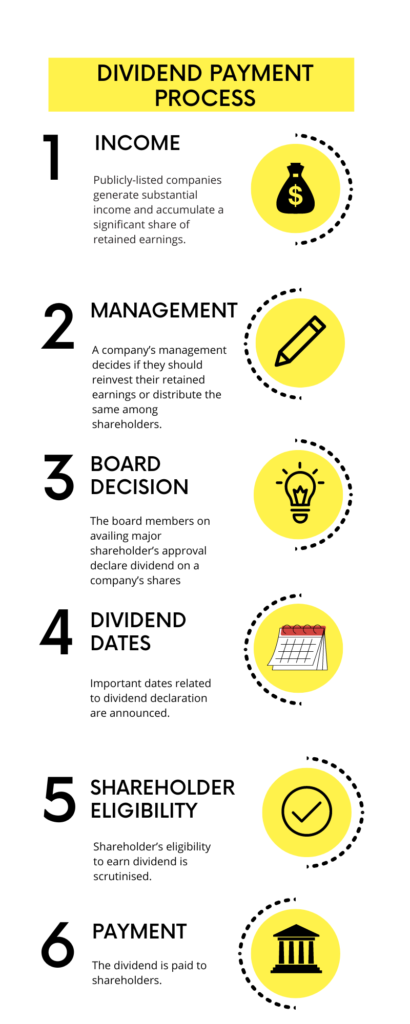Table of Contents
When a company shares it’s profits or earnings with it’s shareholders or owners, it is called ‘dividend’. Dividend is a distribution of company’s earnings to its shareholders. When a company makes profits it can either re-invest it in the business or pay it to the owners in the form of dividend. A dividend yield is the annual dividend per share divided by the share price.
Dividend payout ratio indicates the portion of a companies net earnings offered as dividend income. The formula for calculating the dividend payout ratio is Dividends/Net Ratio, where the net ratio is calculated as (Net Profit / Net Sales) x 100.
Dividends can be in the form of cash or stock. The payment of dividend must be approved by the Board of Directors of the Company. When a dividend is declared it will be paid on a certain date, called the payment date.
Steps in Dividend Payment Process

Important Dividend Dates
- Declaration Date – The date when the company’s Board of Directors announce a dividend payout is called the ‘declaration date’.
- Record Date – The dividend is paid to all shareholders of the company whose name appears in the shareholder records of the company at the end of the record date. So, if a company declares a dividend with record date as 22 May, then all shareholders whose name was in the shareholder register at the end of 22 May will receive dividend.
- Ex-dividend Date – The ex-dividend date is generally set 2 days prior to the record date. The reason being, trades are normally settled in T+2 days in India. So to determine the eligible shareholders for dividend payouts, the ex-dividend date plays a crucial role. Continuing with our example, the ex-dividend date would be 20 May. This means the investor would have to buy stocks before 20 May to be eligible to receive dividend.
- Payment Date – This is the date when shareholders receive their dividend amount.
Types of Dividend
- Special Dividend – This type of dividend is paid on common stock. It is often issued when a company has accumulated substantial profits over several years. Such profits are looked at as excess cash that do not need to be used currently or in the immediate future.
- Preferred Dividend – This dividend is paid to preference shareholders. It is normally a fixed amount which is paid out quarterly.
- Interim Dividend – In India, the financial year is April to March. Interim dividends are paid before a company’s annual general meeting and before the release of financial statements.
- Final Dividend – A final dividend is dividend declared after the company has issued its full year financial statements.
Taxation of Dividends in India
- Dividend received from an Indian Company – Since 1 April 2020, the dividend income is taxable in the hands of the investor/shareholder at the normal applicable tax rates. Companies and mutual funds distributing dividend after 1 April 2020, have to now deduct TDS on dividend paid.
- Dividend received from a Foreign Company – Dividend received from a foreign company is also taxable in the hands of the investor/shareholder at the normal applicable tax rates. The foreign company will also deduct TDS on dividend paid.
- Deduction of expense from dividend income – The Finance Act 2020, allows deduction of interest expense incurred against dividend income. However the deduction cannot exceed 20% of the dividend income. Lets understand with an example. Suppose Bhavik, borrowed money to invest in shares and paid an interest of Rs 5,000 on the borrowing. He earned a dividend income of Rs 9,000 on these shares. In this case Bhavik can claim a deduction of interest expense limited to 20% of Rs 9,000 which is Rs 1,800.
Image credits: Image by Freepik



